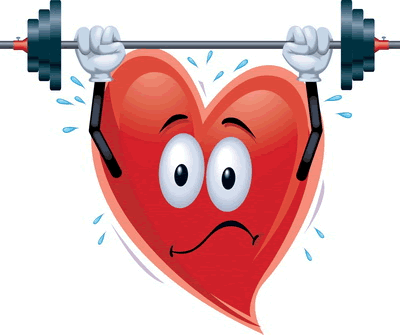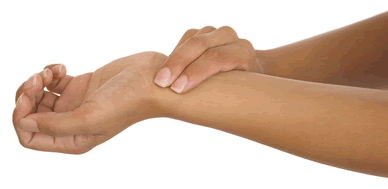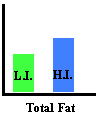Cardiovascular fitness can be defined simply as your body's ability to get oxygen and blood to the muscles.
-
When you do physical activity and your pulse quickens and your breathing gets deeper, you are using your cardiovascular system.
-
You can improve your cardiovascular system's efficiency through regular training.
-
The short term used when referring to cardiovascular exercise is Cardio.
How Much Cardio Do I Need to Do?
There are a few simple guidelines you can follow when determining how much cardio work you should do. Basically, it all comes down to your goals.
- If you're trying to lose fat, you need to do more cardio than if you are trying to gain weight. For fat loss, three to five times per week at 20 to 40 minutes per session is plenty. Start conservatively if you are just starting training, e.g. three times per week, 20 minutes per session.
- If you're trying to gain weight, you will find that goal easier to achieve if you don't do any cardio at all, though you will still maintain health benefits without much effect on your weight gain if you do light cardio work twice a week for 15-20 minutes.
- For improving cardiovascular fitness in general, three or four times per week for 20 to 40 minutes per session (depending on your current level of fitness) will yield good results.
Which Type of Cardio Should I Do?
Cardiovascular training, no matter what the exercise, is categorized based on duration and intensity. When you are choosing which type of cardio to do, keep your goals in mind.
- If your goal is to improve your general cardiovascular fitness, do moderate intensity work where you are starting to breathe deeply and you can feel that you are working..
- If your goal is fat loss but you're in poor shape or just starting out, I would recommend low intensity, long duration, low-impact cardio such as walking or cycling.
- If you want fast fat loss and you're in reasonably good cardiovascular shape, you may wish to increase the intensity with high-intensity interval training.
Maximum Heart Rate
- Your maximum heart rate (HR max) is the theoretical number of beats per minute that your heart is capable of producing.
- This is found by subtracting your age from 220, e.g. if you're 40 years old, 220 - 40 = 180 HR max.
- This is simply an estimation, not an absolute limit.
- To measure aerobic exercise intensity, percentage of HR max (%HR max) is often used. If you want to exercise at 60% of your HR max, your heart rate should be, using the example above, around 108 beats per minute.
- Your heart rate is your guide for cardiovascular exercise intensity.

Target Heart Rate
Your Target Heart Rate is the range of heart beats per minute at which you should work at in order to best achieve aerobic fitness. This range is typically between 60% to 80% of your HR max. The bottom end of the scale is best for low intensity training while the top end is for high intensity training.
How To Take Your Heart Rate
The first location is on the inside of the wrist below your thumb. Use your forefinger and middle finger to feel the pulse (this is known as palpation).

The second site is on the carotid artery on the neck (either side). Place your fingers on the side of your windpipe, just below the jaw.

Count the beats for 10 seconds then multiply by six to get beats per minute. This count can last for 10 seconds, 15 seconds, 20 seconds, 30 seconds or a full minute. Multiply by 6, 4, 3, and 2 respectively to get beats per minute.
- An electronic heart rate monitor that is strapped to your chest or on a watch can also be used to keep track of your heart rate (the chest strap style is usually more accurate, being much closer to your heart).
- There are also some cardio machines that have touch sensitive pads on the handlebars that can take your pulse by counting the electrical signals of your heart beat. Make sure the pads are clean and dry and grip them firmly.
The Low Intensity = Fat Loss Myth
It is a myth that low intensity is best for fat loss just because more fat is burned for fuel as a percentage of the total calories burned.
Low Intensity (L.I. for short) burns about 50% fat for fuel while High Intensity (H.I.) burns about 40%. This is not a big difference.
Say, for example, you burn 100 calories in 20 minutes of L.I. work compared to 160 calories in 10 minutes of HI work, you've still burned more total fat doing HI.
Low Intensity
100 calories x 50% = 50 calories
High Intensity
160 calories x 40% = 64 calories

High intensity training will also boost your metabolism long AFTER the workout is done. This does not happen with low intensity training. High Intensity training is a powerful fat loss tool, but should only be used by trainers who already have a good level of fitness.
The basic idea when you're trying to lose fat is to create a caloric deficit. The type of training does not matter so much as creating that deficit. High Intensity training just creates the deficit more efficiently than Low Intensity training.
Aerobic Training vs. Anaerobic Training
Aerobic literally means with oxygen while anaerobic means without oxygen.
- The Aerobic training zone is the training intensity where you are burning fuel with oxygen.
- The Anaerobic training zone is the training intensity where you are burning fuel without oxygen.
The Anaerobic Threshold is the point at which the aerobic, oxygen-burning system can no longer supply enough energy to meet the demands of the exercise and you begin to produce lactic acid. Once over 85% HR max, you will not last longer than a few minutes unless you decrease the intensity. High caliber endurance athletes can feel the point where they are about to cross their Anaerobic Threshold and can operate for long periods of time just below it.
Cardio and Weight Training
The best way to incorporate cardio into your training is to do it in a completely different session then your weight training. If you plan on doing both weights and cardio in the same session, do the weights first. There are two major reasons for this:
- First, doing cardio before weights will pre-fatigue your muscles, limiting your weight training. Doing cardio after weights will not.
- Second, weight training will serve as a sort of pre-exhaust for cardio; lowering your blood sugar and allowing you to burn fat immediately after you start cardio. If you do cardio first, it will take about 20 minutes before you really start to burn fat
Here are examples of cardiovascular exercise.
![]()
More From Fitstep.com
| Stink Training for Bringing Up Weak Bodyparts | |
| How Do I Get Rid of My Man-Boobs? | |
| The Funniest Fitness Pics From Around the Web | |
| This Killer Core Exercise Will Leave You Crawling |
Share This Page...
---
Home -> Fitness For Beginners -> Cardio Fitness -> What Is Cardio



